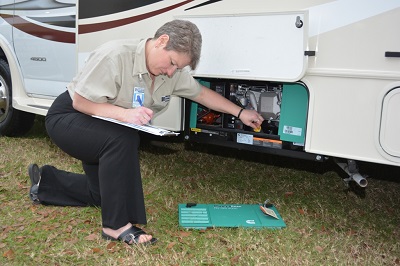
A new survey conducted by the National RV Inspectors Association (NRVIA) found support for consumers getting RV inspections before purchases.
The survey of NRVIA members, conducted in May, found buyers purchased RVs after inspections 90% of the time. The purchases came despite 35% of inspections revealing major issues – such as system or appliance failures – and 20% revealing life-safety issues, such as hot skin, problems with safety detectors or alarms, needed gas line repairs and improper running gear.
“The overwhelming message we took away from the survey is that RV buyers will still purchase an RV even if it has issues, so long as the issues are discovered and addressed by the dealership,” said Stephanie Henson, NRVIA director of administration. “Dealers who choose to turn away third-party inspectors are instilling fear and suspicion into their customers by not allowing an RV to be inspected. The dealers give an impression there is something wrong with the unit which they need to hide.”
Henson said several issues could keep dealers from conducting inspections, including the length of time and space needed. Inspections can take up to eight hours, she said, and dealers might be concerned with an inspector occupying bay space. Dealers may believe they will incur liability if a third-party inspector is injured or property is damaged during an inspection.
Those issues can be addressed, Henson said. Inspections can be performed anywhere the RV can access electricity and NRVIA-certified inspectors are required to carry professional liability insurance coverage to mitigate liability concerns.
Some dealers may believe inspections performed by their staff are sufficient to identify problems, Henson said. before units are put up for sale. However, Henson listed several problems during recent inspections found after dealers approved the RVs:
- All of the plumbing was missing under a bathroom sink.
- Small holes or cracks in the roof that would allow water to leak inside the RV.
- A broken axle that would not have allowed the RV to be safely towed.
- A missing GFCI outlet resulting in an open ground electrical problem throughout the coach.
- Recliner chair not bolted to the floor.
- A roof so rotted that an inspector almost fell through when walking on it.
- The water heater would not work when connected to electricity.
- A P-trap under the shower drain was not connected to any piping.
- Problems with entry doors not closing properly due to bent frames.
- Refrigerator would not cool below 40 degrees.
- Shattered solar panels on the roof.
“As much as dealership technicians try to evaluate every new or used RV coming on to the lot, they are overwhelmed with so much work this year that they cannot give initial evaluations the time required to truly identify all potential problems with an RV,” Henson said.
Inspections also can be used to move stale inventory. An RV dealer in Arkansas reported success moving older units off the lot by taking advantage of NRVIA’s Certified Pre-Owned Inspection program, said Terry “Cooper” Cooper, founder of NRVIA.
Detailed inspections were performed and made available to prospective buyers, along with documentation that deficiencies were addressed or scheduled for repair later.
“A salesperson sat with buyers inside the air-conditioned RV and reviewed the inspection report together so questions could be answered and customers had confidence the RV they were buying was a good investment,” Cooper said. “Units marketed with an NRVIA Certified Pre-owned Inspection usually sold within two weeks of being listed – for the asking price – despite the fact the unit had originally been on the sales lot for several months.”




